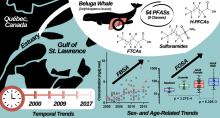| Title | Dynamic Wood Smoke Aerosol Toxicity during Oxidative Atmospheric Aging. |
| Publication Type | Journal Article |
| Year of Publication | 2023 |
| Authors | Wang, S, Gallimore, PJ, Liu-Kang, C, Yeung, K, Campbell, SJ, Utinger, B, Liu, T, Peng, H, Kalberer, M, Chan, AWH, Abbatt, JPD |
| Journal | Environ Sci Technol |
| Date Published | 2023 Jan 11 |
| ISSN | 1520-5851 |
| Abstract | Wildfires are a major source of biomass burning aerosol to the atmosphere, with their incidence and intensity expected to increase in a warmer future climate. However, the toxicity evolution of biomass burning organic aerosol (BBOA) during atmospheric aging remains poorly understood. In this study, we report a unique set of chemical and toxicological metrics of BBOA from pine wood smoldering during multiphase aging by gas-phase hydroxyl radicals (OH). Both the fresh and OH-aged BBOA show activity relevant to adverse health outcomes. The results from two acellular assays (DTT and DCFH) show significant oxidative potential (OP) and reactive oxygen species (ROS) formation in OH-aged BBOA. Also, radical concentrations in the aerosol assessed by electron paramagnetic resonance (EPR) spectroscopy increased by 50% following heterogeneous aging. This enhancement was accompanied by a transition from predominantly carbon-centered radicals (85%) in the fresh aerosol to predominantly oxygen-centered radicals (76%) following aging. Both the fresh and aged biomass burning aerosols trigger prominent antioxidant defense during the exposure, indicating the induction of oxidative stress by BBOA in the atmosphere. By connecting chemical composition and toxicity using an integrated approach, we show that short-term aging initiated by OH radicals can produce biomass burning particles with a higher particle-bound ROS generation capacity, which are therefore a more relevant exposure hazard for residents in large population centers close to wildfire regions than previously studied fresh biomass burning emissions. |
| DOI | 10.1021/acs.est.2c05929 |
| Alternate Journal | Environ Sci Technol |
| PubMed ID | 36630690 |
Environmental Chemical Biology

